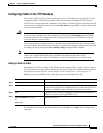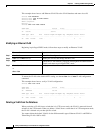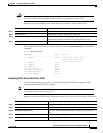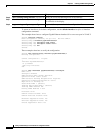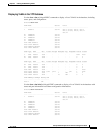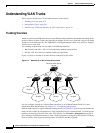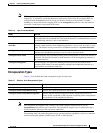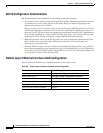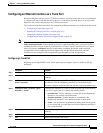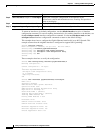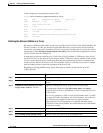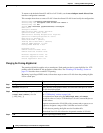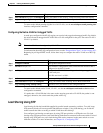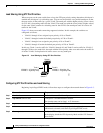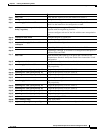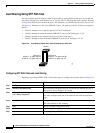
9-25
Catalyst 3550 Multilayer Switch Software Configuration Guide
78-11194-03
Chapter 9 Creating and Maintaining VLANs
Understanding VLAN Trunks
Configuring an Ethernet Interface as a Trunk Port
Because trunk ports send and receive VTP advertisements, you must ensure that at least one trunk port
is configured on the switch and that this trunk port is connected to the trunk port of a second switch.
Otherwise, the switch cannot receive any VTP advertisements.
This section includes these procedures for configuring an Ethernet interface as a trunk port on the switch:
• Configuring a Trunk Port, page 9-25
• Defining the Allowed VLANs on a Trunk, page 9-27
• Changing the Pruning-Eligible List, page 9-28
• Configuring the Native VLAN for Untagged Traffic, page 9-29
Note By default, an interface is in Layer 2 mode. The default mode for Layer 2 interfaces is switchport
mode dynamic desirable. If the neighboring interface supports trunking and is configured to allow
trunking, the link is a Layer 2 trunk or, if the interface is in Layer 3 mode, it becomes a Layer 2 trunk
when you enter the switchport interface configuration command. By default, trunks negotiate
encapsulation. If the neighboring interface supports ISL and 802.1Q encapsulation and both
interfaces are set to negotiate the encapsulation type, the trunk uses ISL encapsulation.
Configuring a Trunk Port
Beginning in privileged EXEC mode, follow these steps to configure a port as an ISL or 802.1Q
trunk port:
Command Purpose
Step 1
configure terminal Enter global configuration mode.
Step 2
interface interface-id Enter the interface configuration mode and the port to be configured for
trunking.
Step 3
switchport trunk encapsulation {isl |
dot1q | negotiate}
Configure the port to support ISL or 802.1Q encapsulation or to negotiate
(the default) with the neighboring interface for encapsulation type.
You must configure each end of the link with the same encapsulation type.
Step 4
switchport mode {dynamic {auto |
desirable} | trunk}
Configure the interface as a Layer 2 trunk (required only if the interface
is a Layer 2 access port or to specify the trunking mode).
• dynamic auto—Set the interface to a trunk link if the neighboring
interface is set to trunk or desirable mode.
• dynamic desirable—Set the interface to a trunk link if the
neighboring interface is set to trunk, desirable, or auto mode.
• trunk—Set the interface in permanent trunking mode and negotiate
to convert the link to a trunk link even if the neighboring interface is
not a trunk interface.
Step 5
switchport access vlan vlan-id (Optional) Specify the default VLAN, which is used if the interface stops
trunking.
Step 6
switchport trunk native vlan vlan-id For 802.1Q trunks, specify the native VLAN.
Step 7
end Return to privileged EXEC mode.



